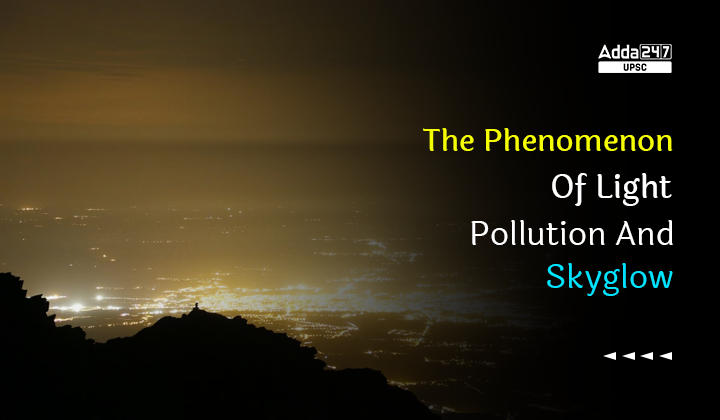Table of Contents
Skyglow Light Pollution
Skyglow Light Pollution: New research shows that The number of stars that we see with our naked eyes in the sky has reduced significantly over the last decade. The cause is “Skyglow Light Pollution” worldwide. ‘Skyglow Light Pollution(Brightening Night Sky)’ has significant ecological, health and cultural consequences.
Context Of Skyglow Light Pollution
Indian Context
- On December 14, 2022, the district administration of Ladakh designated six hamlets within the Changthang Wildlife Sanctuary as a “darksky reserve” — an area whose sky is free of light pollution.
- The designation meant that the reserve had a responsibility to keep the skies dark, particularly for the astronomical observatories located in the area.
International Context
- A group of amateur astronomers and citizen scientists spent the last 12 years studying the sky to reach this conclusion.
- The amount of light that humans emit in the sky has constantly increased by 10% every year, as per the researchers.
India’s First-ever “Night Sky Sanctuary” to be Set up in Ladakh
What Is Skyglow Light Pollution?
- Skyglow is the brightening of the night sky, mostly over urban areas, due to the electric lights of cars, streetlamps, offices, factories, outdoor advertising, and buildings, turning night into day for people who work and play long after sunset.
- People living in cities with high levels of sky glow have a hard time seeing more than a handful of stars at night. Astronomers are particularly concerned with sky glow pollution as it reduces their ability to view celestial objects.
- More than 80 percent of the world’s population, and 99 percent of Americans and Europeans, live under sky glow.
- It sounds pretty, but sky glow caused by anthropogenic activities is one of the most pervasive forms of light pollution.
What Does The Research On Skyglow Light Pollution Says?
- Numerous studies have also found that artificial light at night affects both people and wildlife in significant ways.
- According to a 2003 report, lit beaches deter sea turtles from coming ashore to nest.
- A 2006 review found that skyglow keeps trees from sensing seasonal variations.

- A 2017 study found that young burrownesting seabirds don’t take flight unless the nesting site becomes dark.
- A 2019 study reported that clownfish eggs don’t hatch when exposed to artificial light at night, killing the offspring.
- A 2020 study noted that skyglow interferes with multiple aspects of insect life and allows insect predators to hunt for longer.
- By disrupting the circadian rhythm, artificial light at night can hamper the production of melatonin, an influential hormone in the human body which affects sleep, moods and cognition.
- A small 2009 review concluded that circadian disruption increased the risk of breast cancer among nightshift workers by 40%.
- In 2020, Australian researchers wrote in a paper, “The erasure of the night sky acts to erase Indigenous connection to the stars, acting as a form of ongoing cultural and ecological genocide.”
| Important Fact: Light pollution and its impact on migratory birds was the focus of World Migratory Bird Day 2022 and Parties to the Convention on Migratory Species adopted guidelines to address the problem of Skyglow Light Pollution at their meeting in Gandhinagar in 2020. |
How LED Lighting Contributes To Light Pollution?
- The European Space Agency in a study last year revealed that the LED lighting revolution throughout the world exacerbated the light pollution problem.
- The cheaper and better the lightning, the more it is wasted. Decorative lights, advertisement boards, street lights and lights on high-rise buildings have made our sky brighter and the light problem worse.
Yojana Magazine(September 2022): Scope Of Space Centres in J & K and Ladakh
Threats From Light Pollution
Disrupted Sleeping Patterns
- Light pollution doesn’t just spoil the mesmerising view of the moon and stars, it also gravely impacts the sleeping behaviour of humans.
- Excessive lighting is linked to disrupted sleeping patterns and bad health, not just in humans but animals also. One study even linked excessive lighting to the local insect decline.
Massive wastage of energy
- Experts say that skyglow and sky brightness show how a tremendous amount of energy is being wasted every day, without people and governments even acknowledging this massive loss.



 TSPSC Group 1 Question Paper 2024, Downl...
TSPSC Group 1 Question Paper 2024, Downl...
 TSPSC Group 1 Answer key 2024 Out, Downl...
TSPSC Group 1 Answer key 2024 Out, Downl...
 UPSC Prelims 2024 Question Paper, Downlo...
UPSC Prelims 2024 Question Paper, Downlo...




